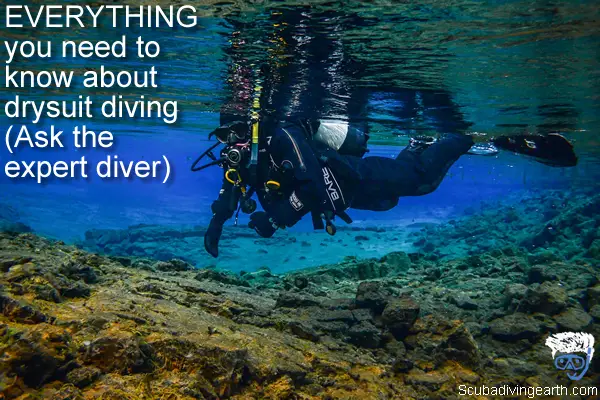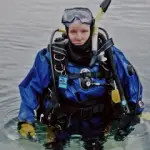Drysuit diving advice; what, why and where do scuba divers use dry suits

Drysuit diving is necessary for scuba diving in colder waters. Plus for safety reasons it’s necessary to have specific training before venturing under the water for the first time in a dry suit.
What is drysuit diving and EVERYTHING you need to know about diving in a drysuit in 15 seconds: Depending on your personal tolerance to cold a drysuit is usually necessary for diving below 14-21°C (57-70°F). Water sucks heat away from your body 25 times faster than air at the same temperature. Which means if you’re diving in cold water you must use the correct exposure suit to protect yourself from hypothermia.
The best way to do more diving in your drysuit is to book yourself on a scuba diving liveaboard, as there are a few places where a drysuit is better than a wetsuit to keep you warm (e.g. Mexico’s Guadalupe Island and The Galapagos Islands). You can check the latest and best deals on liveaboards using the following window:
What is dry suit diving?
Diving in a drysuit becomes necessary when the water temperature drops below 14-21°C (57-70°F), but this does depend on personal preference and tolerance to the cold.
A drysuit is better at keeping a diver warm in colder waters than a wetsuit is. This is because a drysuit keeps you dry rather than relying a layer of water under the suit in the case of a wetsuit to keep you warm.
Most divers know that water sucks heat away of your body 25 times faster than air of the same temperature. In fact water is like a massive heat-sink, which is why we sweat.
Although heat loss through sweating relies on the evaporation of the water on your skin, it does also reply on the layer of sweat or water transferring the heat away from your body first.
For example, in the UK room temperature tends to be around 21°C (57°F) and feels comfortable. However, swimming in water at the same temperature without at the very least wearing a wetsuit, would feel quite cold in contrast.
More Reading: What is the difference between a wetsuit and a dry suit?
In fact heat loss whilst scuba diving is one of the main contributing factors to why scuba diving burns big calories. Which is despite the sport being a slow moving sport. The amount of calories you burn is reduced by wearing the correct exposure suit of course.
So if you want to dive in cold water you must use the correct exposure suit, which in this case is a drysuit. This will ensure you enjoy the dive and feel comfortably warm. But also it will protect you from hypothermia and help you to use less air.
Dry suit diving temperature
A dry suit does this perfectly in colder waters. I’d suggest you use a drysuit in water temperature below 14-21°C (57-70°F), but this personal tolerance to the cold.
However, you could alternatively use a semi-dry suit instead of a dry suit. But there are pros and cons of using a semi-dry suit.
Drysuit diving in colder water works well because the suit keeps the water out and keeps you dry. You are surrounded by a layer of air around the body, which is what keeps you warm.
More Reading: What is the difference between a drysuit and a semi dry suit?

How does a dry suit work?
A drysuit is a waterproof suit that seals a layer of air between you as the diver and the water on the outside. It is this layer of air that gives a drysuit the advantage over a wetsuit in colder waters.
It is because you stay dry in a dry suit underwater and because air conducts heat away from you more slowly than water that you’ll not lose body heat as quickly as you do in a wetsuit.
Getting a correctly fitting drysuit is key, so you may also like to read about how tight a drysuit should be. This article includes a drysuit fitting guide too and how to check whether it’s too tight before buying.
Why go dry suit diving?
Not only can everyone afford to scuba dive in exotic locations many scuba divers dream about. But not only that, there are some great diving destinations where the diving is great despite the fact it’s in cold water.
Diving somewhere local or nearby can sometimes mean it’s going to be cold. For example, if you live in the UK you can pretty much guarantee the waters around the UK are going to be cod year-round.
But also, if you live in America, there are certain coasts in the USA that have waters that are just as cod as UK waters and in some places even colder!
Fantastic places to scuba dive in a drysuit
But please take it from me, there’s some fantastic diving to be found in cold waters where a drysuit will make sure you’re toasty warm and can dive comfortably and not get cold.
For example, one of my favourite dive sites in the UK is the Farne Islands. Here you’ll enjoy the company of many seals, as there’s a large seal colony here off the coast of Northumberland.
More Reading: Farne Islands Diving With Seals (Best UK Place To Scuba Dive With Seals)
The other top dive destination in the UK is to dive on the wrecks of Scapa Flow. Scapa flow is a top dive location for tech divers, as the wrecks are deep and require decompression stop diving in most cases.
But then if you get a bit more adventurous, why not try scuba diving under the ice in either the Arctic or the Antarctic!
More Reading: The best tech diving liveaboard Red Sea (34 Tech diving liveaboards)
The other dive destination I used my dry suit is in South Africa. Whilst a dry suit is not absolutely necessary when scuba diving in South Africa, for me it kept me warm when everyone else on the dive boat got very cold.
It was a cold day and it rained for much of the day. Combine getting wet in a wet suit with the wind you are going to get cold. But in a dry suit you remain warm instead.
More Reading: Where is the best place to cage dive with sharks (5 Best great white spots)
Drysuit training before you dive
Before you go diving in a dry suit you’ll need to do additional training.
Drysuit diving is quite different to wetsuit diving. A drysuit is a new piece of diving equipment to think about and to use correctly in order to have a safe dive.
Most scuba divers who use a dry suit use it for buoyancy control instead of their buoyancy control device or BCD. Not only that, due to the fact that your drysuit is filled with air you’ll require more weight to be added as you’ll be more buoyant than you are in a wetsuit.
Drysuit training for your own safety how to get dry suit certified
One of the safety concerns of scuba diving in a dry suit is the possibility of getting inverted underwater. This is when the air in your drysuit goes to your feet. This could cause you to rush to the surface with no way to dump air.
However, with proper dry suit training, this problem with be explained and you’ll be shown how to prevent this problem from occuring in the first place. But should it happen, you’ll also be shown how to correct it and continue your dive safely.
Therefore, for these reasons I strongly recommended that you complete a dry suit orientation dive in a confined environment (like a swimming pool) with a certified professional before venturing out on your first drysuit dive in the sea or ocean.
How to get dry suit certified
After this, I’d also recommend you complete a PADI dry suit specialty course or BSAC drysuit training course. BSAC’s Drysuit Training course will teach you how to dive safely in a drysuit. This will help you to keep warm and more comfortable in cold-water conditions.
On the PADI drysuit diving course they cover:
- Discover is which dry suit style and accompanying undergarments are right for you and the diving you’ll do.
- Learn how to take care of your dry suit.
- A confined session and two open water dives. These will allow you to get comfortable with your dry suit. It also includes mastering buoyancy control using your dry suit and dive safety procedures using a drysuit.
“Becoming a dry suit diver allows you to expand your boundaries and dive more places, more often. This suit seals you off from the water and keeps you comfortable, even in surprisingly cold water.”
PADI
On the BSAC drysuit diving course they cover:
- How drysuits work and get practical experience of drysuit diving techniques.
- Two theory sessions cover what to look for when buying different types of drysuit and the use and maintenance of drysuits.
- Practical lessons in sheltered and open water cover how to dive safely in a drysuit, including what to do if you become overinflated both during a dive and at the surface and how to manage a rescue scenario involving drysuit divers.
What to consider when purchasing a dry suit
Dry suits are much more expensive pieces of equipment than wetsuits or semi-dry suits. Because of this, it’s important to consider a number of factors when choosing to purchase your own first dry suit.
But before you do so, I’d certainly recommend hiring a drysuit first and trying a few different types before you commit to buying one.
Types of material drysuits are made from
Dry suits are made from many different types of materials, these are as follows:
- Neoprene (just like a wetsuit). The neoprene suit itself provides the insulation along with the layer of air inside, just like it does with a wetsuit. However, it keeps you warmer than a wetsuit because instead of having a layer of water next to your skin, this is air instead.
- Crushed neoprene. You need to wear a wool-bear for insulation to keep you warm, as the ‘crushing’ of the neoprene takes away its insulating properties. But the benefit of crushed neoprene dry suits is their comfort and flexibility. This is my preference and the suit I use.
- Trilaminate. You need to wear a wool-bear for insulation to keep you warm and the trilaminate isn’t flexible like crushed neoprene.
- Vulcanised rubber. You need to wear a wool-bear for insulation to keep you warm and the vulcanised runner isn’t as flexible as crushed neoprene.
How to choose your first drysuit
When finally come to choose your dry suit it will come down to your personal preference.
As mentioned above, I prefer my crushed neoprene dry suit, but many prefer the neoprene dry suit and other swear by the trilaminate dry suits.
If in doubt ask someone or get help at the dive shop where you intend to buy your suit.
Now that we’ve looked at the material the drysuit is made from, let’s take a look at the other five main drysuit components that help keep you dry. These are the neck and wrist seals, the ‘dry zip‘, the inflator valve, the dump valves and the boots or boots.
Drysuit seals
Drysuits come with two seal types, as follows:
- Neoprene neck and wrist seal. These are found on the neoprene drysuits. This means that on a neoprene drysuit, both the wrist and neck seals are made from neoprene. It is the neoprene that forms the seal against your skin to create a watertight seal to the the water out and keep you warm.
- Latex neck and wrist seals. Latex seals are found on crushed neoprene, membrane and trilaminate drysuits. It is the soft latex that creates a watertight seal around your neck and your wrists to keep the water and out you warm. The problem with latex is that it’s much more delicate than neoprene, so it can tear. But it can also cause allergies for some divers.
The dry zip on a drysuit
The only way in and out of a dry suit is through an opening, which is closed and sealed with a zip. It is this zip that needs to be watertight and is a special dry zip. In fact the design of a dry suit dry zip originally came from a design used on space suits.
As the dry zip is one of the most important components of your dry suit, it’s important to take care of it.
Always wash your drysuit after a dive, especially after diving in salt water. Also, keep the zip lubricated to avoid it snagging and the lubricant will help to keep it sealed tight.
There are different types of drysuit entry zips. Most designs use a zip across your shoulders., but there are some drysuits that have a zip on the front of the suit too. Other drysuits also ‘pee zips‘,which is only useful to male scuba divers and not any use to female divers.
However, just in case, please be aware pee zips are to be used on the surface use only. If you were to open this up underwater, your drysuit would fill up with water.
Dry suit valves – dump valves and inflator valves
All dry suits have two types of valve. #The first of these is the inflator valve, which is located at the front of the suit. This valve is connected via a special low-pressure hose on your regulator. To connect this low-pressure hose, you’ll need a spare port to connect it to.
This inflator valve is used to inflate your drysuit to not only provide buoyancy as you descent, but also to avoid what’s known as drysuit squeeze. As already explained, it is this air that provides the warmth, but most divers who use a drysuit to dive use it for buoyancy control too.
More Reading: What causes dry suit squeeze? (How to prevent dry suit squeeze)
In addition to an inflator valve, dry suits also have air dump valves. These are necessary to dump the air from inside the drysuit on your ascent. Dump valves are usually found on your shoulder and on your cuff.
The cuff dump is the one mostly used, as you can extend your arm up to make sure the air migrates to the highest point to make it easy to control your ascent and buoyancy.
Boots vs socks on a drysuit
Depending on the type of drysuit you buy, will depend on the type of boot of sock covers your feet.
Some drysuits come with socks, for example the DUI crushed neoprene suits have socks with rock-boots you put on to cover the sock. Whereas other drysuits have built-in boots.
In both cases, the boots are necessary to avoid puncturing the drysuit when walking on land or jagged surfaces. But also, it makes it more comfortable if you end up walking on rocky or stone surfaces.
What can go wrong with a dry suit?
There are other things to consider when drysuit diving. The first is that drysuits can sometimes leak.
Drysuit leaks can happen for a number of reasons:
- A faulty or damaged dry zip which can happen as the zip wears out or due to poor maintenance. A faulty or damaged zip can be replaced.
- A puncture in the drysuit material. Holes in the drysuit material can be repaired.
- Faulty or damaged valves. Over time the dump valves can wear out of the seals can get damaged and leak. These can be repaired or replaced.
- Neck and wrist seals tear or lose their integrity. During use and over time the next and wrist seals on a dry suit can wear. This is particularly true of the latex seals. However, these can be replaced.
You’ll soon know if your drysuit has a leak. If the leak is small you’ll feel it and you may begin to get cold. There’s no reason to abort the dive with just a small hole, but if the water leak is much larger, you’ll need to abort the dive for your own safety.
To check for leaks before you dive, you can have it pressure tested. If the pressure test fails, you can have the suit fixed, which will avoid you getting wet when you dive.
I hope you enjoyed this article about drysuit diving
I’d love to hear from you. Tell us about your adventures of diving and snorkeling, in the comments below. Please also share your photos. Either from your underwater cameras or videos from your waterproof go-pro’s!
If this article hasn’t answered all of your questions. If you have more questions either about snorkeling or scuba diving (or specifically about drysuit diving), please comment below with your questions.
There will also be many more articles about scuba and scuba diving safety tips (and on snorkeling too) for you to read and learn about this fabulous sport.
Have fun and be safe!





